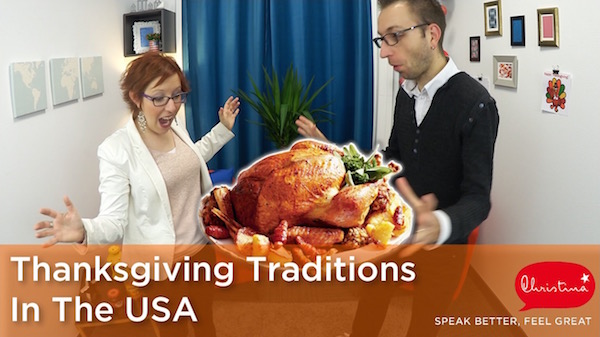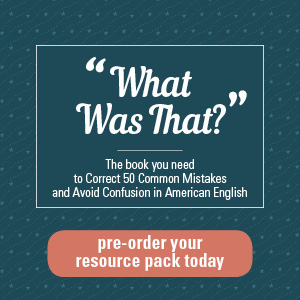
Every Thanksgiving, we used to go (on avait l’habitude d’aller) to my grandma’s house for a HUGE lunch (un déjeuner énorme) with my HUGE family. As a kid, Thanksgiving was just a big meal. But more and more, I really see it as a time to think about all the good things I have in my life and to be thankful for them.
But what exactly is Thanksgiving?
What will your American colleagues be doing for this typically American holiday? The best way to find out (le meilleur moyen de savoir) is to ask them!
Before, though, you’ll want to watch this week’s SBFG video. After all, I kind of think of myself (je me vois un peu) as your American colleague, since we work together to boost your English 🙂You’ll learn all about what we do on Thanksgiving, what we eat, and even a special connection that France has to one of the greatest American Thanksgiving traditions: football! (The American kind, not the rest-of-the world kind).
You’ll get a lot of vocabulary for talking about Thanksgiving and holidays in general. After all, good food, family, and fun are part of any good holiday!
You can celebrate Thanksgiving too, with these recipes (des recettes):
For dressing, homemade cranberry sauce, and THE green bean casserole that my mom makes every year (and that I love!)
I also recommend the site MyAmericanMarket.com if you want to taste some real American products. The StoveTop stuffing is to die for (at least for this American—best stuff ever!)
Finally, I hope you enjoyed watching this video. I know that I’m going to enjoy eating the cranberry sauce and pumpkin purée (that I’m going to use to make a pumpkin pie) used in creating today’s episode! Yum!
The Macy’s Day Parade is also live streamed, and you can watch this year’s parade here (live Thursday at 9 am New York Time / 4 pm Paris time), or watch a recording of the 2013 parade. It’s as much a Thanksgiving tradition as the roast turkey!
Now, I’d be very grateful (je serais très reconnaissante) if you shared something with the SBFG community:
Have you ever had any typical Thanksgiving dishes?
Or what other questions do you have about Thanksgiving?
Thousands of other French-speaking professionals come to SBFG to boost their English and boost their career. It’s the best place to start conversations, because we’re all here to learn. It takes 2 people to have a conversation, and conversation is the best way we can help each other.
From the bottom of my heart, (Du fond du coeur) thank you for making SBFG such a great place. I love what I do, thanks to you.
Happy Thanksgiving,
Christina
Each week, Christina sends you a new English lesson!





Thanks for this new video !
I didn’t know the dish “dressing”, I’m surprised !
I have a question about the origins of thanksgiving… At the beginning, wasn’t it the day to thank native American for their help ? You didn’t mention it in the video… Have the origins become not that significant with time ?
*native Americans I mean
Hi Clara,
Thanks for your question, and I’m glad you learned about a new dish. Some people call it “dressing”, and some people call it “stuffing”, but it’s basically the same. I think the big difference is whether you serve it directly on the side (dressing) or if you actually stuff the turkey with it (stuffing), but the dish itself is usually the same, although there are a lot of different recipes!
You’re right that about mentioning the Native Americans. I didn’t, because I couldn’t fit everything in one video. I made a note to myself for next year to make a video about the history of Thanksgiving: Myth vs Reality, and what Americans learn about the holiday, so you’ll see that video next year 🙂
Basically, the legend that we (Americans) all learn in school says that the Pilgrims arrived from England and didn’t know how to survive in the new land. The Native Americans (particularly Squanto and the Wampanoag tribe) helped the English, showed them how to grow food, etc. and when it was harvest time, they all had a big meal to express their thanks to the Native Americans and to God for their good fortune.
In reality, it’s a bit more complicated. At the place where the English arrived in 1620, there are 2 ceremonies every year–the one by Americans of European heritage (to commemorate the arrival of the English and the Thanksgiving event), and one by Native Peoples, for a national day of mourning. When the English arrived, they brought disease and illness to the Natives. The English saw this as a sign from God, as a blessing and approval of their arrival and colonization of the new land.
In fact, Thanksgiving only became a national holiday during the American Civil War (1860-1865), when President Lincoln wanted to create a holiday that would help reunite the nation. And that was just a holiday with a big family meal. The legend of the Pilgrims and Indians became popular around the 1890s.
So, the truth about Thanksgiving is very complex and complicated, but this article give a lot more detail: http://www.sail1620.org/Articles/thanksgiving-on-the-net-roast-bull-with-cranberry-sauce It’s quite long and detailed, but there are some interesting facts in there. Plus, I’ll probably use it and other similar articles to create my Thanksgiving video next year, about truth vs. myth!
Thanks for your complete answer, Christina !
I wanted to ask also a question about the origin of Thanksgiving and you have already given a precise answer.
Thanks a lot
Catherine
Great, Catherine! Thanks for your comment here! I hope I answered your question, but let me know if you have other questions. I’ll be more than happy to answer them! Happy Thanksgiving!